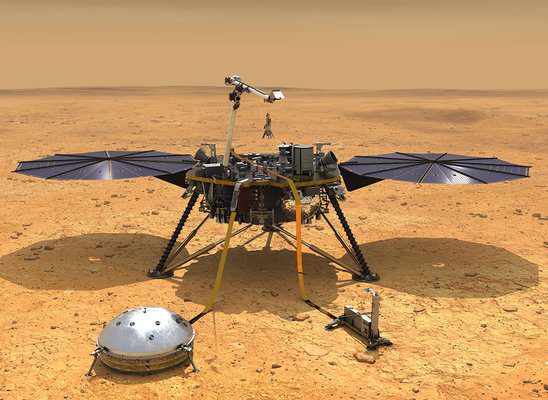InSight has revealed the deep interiors of planet Mars. Insight is a Mars lander. It was developed by NASA. It was launched in 2018. InSight is the first mission by NASA to explore the deep interior of the Red Planet. This is the first time when InSight has provided data about the depth and composition of the crust. The planet’s deep interiors are different from that of Earth’s. It confirmed that the center of Mars is molten. The lander mapped the interior using seismic data. The size and composition of the molten core have come as a huge surprise for the researchers. Notably, Earth’s outer core is molten but the inner core is solid. Scientists believe that Mars is a planet that is quite similar to Earth. The two planets are similar when it comes to their makeup, giving hope that the Red Planet could also be a terrestrial place.
Scientists discovered that the crust of Mars was thinner than expected. The crust has multiple sub-layers. The crust may go as deep as 20 k in the case of the two sub-layers and approximately 37 km with three sub-layers. They said that the mantle below that crust may extend around 1,500 km. The core at the heart of Mars runs 1,830 km in radius. InSight is the only mission by NASA that has studies the planet’s deep interiors. Before this NASA landed multiple rovers and orbiters on the planet. All these rovers studied the planet on its surface. InSight is a stationary lander. Its seismometer revealed the details about Mars’ deep interior. Mars also heats up just like Earth. It is formed from the dust and meteoritic materials that orbit the Sun. Scientists said that Mars was separated into three layers millions of years ago. The three layers are crust, mantle, and core.
InSight’s one of the objectives was to measure these three layers’ depth, size, and structure. InSight team said that it took hundreds of years for scientists to measure Earth’s core. It took around 40 years to measure the core of the Moon. However, it took only two years to measure the core of Mars. The Red Planet has no tectonic plates. The shifting of plates causes earthquakes on Earth. But on Mars, faults in its crust trigger marsquake. The crust is like one huge plate. Faults in the Martian crust because of the stress by the cooling activity of the planet are behind marsquakes. The team detected a direct sound and listened for an echo with the help of the lander’s seismometer. The team is currently managing InSight’s energy level. But the seismometer is still listening to the echoes. According to NASA, InSight had in April 2019 detected its first marsquake. Scientists expect that they will detect a bigger marsquake with the help of InSight.
